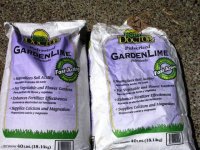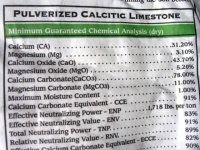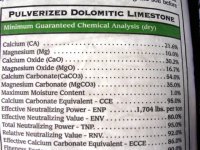I often see questions about Lime and the various brands, concoctions, application methods, amounts and why I should use Dolomite Lime in my soil mix.
A lot of misinformation exists on this subject, and I’d like to present a simple solution to the majority of the problems experienced during a typical grow as well as some facts related to other additives. I strongly believe a lot of the problems that occur during the outdoor season are a result of Calcium/ Magnesium deficiencies or pH fluctuations. These problems are easily and inexpensively remedied.
This is not meant to be a highly scientific foray into chemical analysis and cation exchange - it doesn’t have to be that difficult to grasp or remember for that matter. I’m going to try to keep it as simple as possible for the newbies…
Dolomite Lime- What is it???
It’s a rock, a mineral. Pulverized Dolomite Lime is pure white- like flour- same color and consistency but heavier. Very powdery rock dust. Even this very finest lime takes some time to break down. Any effective liming material will be finely ground. This is important because the rate at which lime raises pH increases with the fineness of the particles. Plus, lime affects only the small volume of soil surrounding each lime particle. A given volume of lime contains more particles if it is finely ground and thus affects more soil than coarser limestone.
If you have organic fertilizer in your soil, you need Pulverized Dolomite Lime. Most fertilizers almost always change the pH of the growing media lower (more acidic). Dolomite Lime stimulates the decomposition of this organic matter. Also, rain water is often acidic. A bag of Pulverized Dolomite Lime will take care of Cal/Mag issues and pH problems yet a 40 pound bag of it is often less than 5 bucks. It should be first on you list of soil amendments! Get the big bag! That sucker is heavy, yeah! You will need 2 Tablespoons per gallon of soil. 1 cup for 8 gallons of soil- if my math is correct… It goes fast at that rate!
It’s best to apply lime 6 months before you intend to plant in the soil for best results. I like to apply it to my soil when there is snow on the ground as it camouflages the application and lets the lime more evenly ‘melt’ into the soil- I come back in the spring and turn the soil over well. Dolomite Lime should be refreshed every year at the recommended rate.
Dolomite Lime will contain both Calcium and Magnesium in an approximate 2:1 ratio. It may also be referred to as Garden Lime. When in doubt of identification, check for the presence of Magnesium in this approximate ratio.
Pulverized Dolomite Lime is most often found in the Lawn section by the grass seed. I’ve bought mine from Ace Hardware stores for the last three years called Soil Doctor Pulverized Garden Lime. I get two bags and thank the owner for stocking it. It’s a very common lawn and garden additive so no paranoia or suspicion is created. I chuck it on my lawn, in the garden, and in, around, and under the wild rose bushes in the patch. Brands like Whitney’s, Scott’s, James River, and Lily Miller can also be used as long as it is Pulverized Dolomite Lime. Wiggle Worm website also carries Garden Lime.
Avoid the following if possible:
Hydrated Lime- Lacks Magnesium. Handling hydrated lime is hazardous. Also called Slaked lime, Quick lime, Pickling Lime, it is best avoided unless you are in the advanced class… Invokes a sudden pH change and may create further toxic conditions…
Pelletized Lime- For years, I used pelletized Espoma Garden Lime in the cute green 5 pound bag. Back then, I also used baby food jars to store my Blueberry nuggets. The more lime and lime containing products I discovered and used, the larger and larger the storage jars became… I hope to move up to the half gallon jar very soon.
What I discovered with Pelletized Lime is the ‘pellet’ isn’t actually lime- it’s clay… Or worse, polymer. These pellets are then rolled in dolomite lime and baked hard. It’s easier to handle and spreads great. Quality of pelletized lime varies tremendously.
Even when crushed, I often wonder how much actual ‘lime’ I’m getting in a cup of Pelletized Lime. I feel the same way about ‘Prilled Lime’.
Additionally, Pelletized Lime difficult to crush and comes out a dull grey or khaki color whereas Pulverized Dolomite Lime is pure white and will disappear into the soil blending in completely when mixed well. Get the Pulverized Dolomite Lime- it’s worth the effort finding this additive.
Egg Shells- Let me start of by saying that you are thinking correctly using egg shells to provide an organic source for (crystalline) calcium carbonate. If it makes you happy, throw these in to your soil after thoroughly crushing them- even still, they break down painfully slow and your special plants won’t see the benefits for years- like after the earthworms eat them and poop them out at best… If there are any earthworms that is, they like the sweet non- acidic soils- get the Lime in there! Same deal for oyster shells even if ground into the finest dust. Both lack Magnesium and it's difficult to gauge the proper amounts of egg shells to add.
Gypsum- Calcium Sulfate. Lacks Magnesium. Often used to break up clay soil- takes about three years. Are you growing in clay??? Probably not. Gypsum is plaster, right? I don’t want to add plaster to my soil then pour on the guano tea. Avoid.
Epsom Salt- Magnesium Sulfate. MgSO4 Wikipedia says Magnesium sulfate is used to correct magnesium deficiency in soil (magnesium is an essential element in the chlorophyll molecule). It is most commonly applied to potted plants, or to magnesium-hungry crops, such as potatoes, roses, tomatoes, peppers and cannabis. The advantage of magnesium sulfate over other magnesium soil amendments (such as dolomite lime) is its high solubility. I feel a very small amount- about a scant quarter teaspoon per gallon of water may be a quick fix for certain relatively rare plant aliments in an emergency. Why not avoid the whole problem by adding 2 Tablespoons of Pulverized Dolomite Lime to the gallon of soil mix before the grow?
Over Liming- Like anything in the soil mix, you can over do it. Too much perlite, too much earthworm castings, too much guano, and you’ve lost the balance in your mix. Avoid the temptation to over lime your soil mix. More is not better in this case…
Believing the Label- There are several high quality soil mixes on the market that advertise lime (or oyster shell) in the mix. Ok, that’s a great start. But how much lime? Well, it’s my experience enough to get you to the third or fourth week of flower before the plant stops flowering and crashes. That’s too long to wait and too much work to take a plant that far for nothing. Your particular strain may not require as much lime as a Cal/Mag hog strain but it won’t hurt a thing to have the pH stable. Get the Pulverized Dolomite Lime in there at the recommended rate.
Using Lime Indoors- Most indoor growers mix a batch of soil shortly before they intend to use it. Keep in mind that Pulverized Dolomite Lime takes at least 6 months to become fully effective. If you’re good at planning ahead then it’s ok- mix the soil and let it ‘cook’ or sit while it’s still slightly moist. It’s best to mix lime with your soil well before you even order the seeds! If you lack this type of foresight, you are better off using a commercial Cal/Mag preparation like Botanicare Cal/Mag Plus 2-0-0 at 3-10 ml per gallon of water depending on plant size and strain. Most nutrient solutions have some form of soluble lime already in the mix- it’s cheap and it works well- take this into consideration when adding Cal/Mag. These solutions are expensive compared to Pulverized Dolomite Lime and the nitrogen contained in them could potentially burn your plants or create a ‘harsh smoke’ if used late into flower… And they don’t do a damn thing for pH which must be monitored closely.
That’s about all you need to know about The Virtues of Dolomite Lime. Considerable research went into this post and I ask you kindly to not contradict my findings without good cause. Thanks! Grow well and make the Seeds…
A lot of misinformation exists on this subject, and I’d like to present a simple solution to the majority of the problems experienced during a typical grow as well as some facts related to other additives. I strongly believe a lot of the problems that occur during the outdoor season are a result of Calcium/ Magnesium deficiencies or pH fluctuations. These problems are easily and inexpensively remedied.
This is not meant to be a highly scientific foray into chemical analysis and cation exchange - it doesn’t have to be that difficult to grasp or remember for that matter. I’m going to try to keep it as simple as possible for the newbies…
Dolomite Lime- What is it???
It’s a rock, a mineral. Pulverized Dolomite Lime is pure white- like flour- same color and consistency but heavier. Very powdery rock dust. Even this very finest lime takes some time to break down. Any effective liming material will be finely ground. This is important because the rate at which lime raises pH increases with the fineness of the particles. Plus, lime affects only the small volume of soil surrounding each lime particle. A given volume of lime contains more particles if it is finely ground and thus affects more soil than coarser limestone.
If you have organic fertilizer in your soil, you need Pulverized Dolomite Lime. Most fertilizers almost always change the pH of the growing media lower (more acidic). Dolomite Lime stimulates the decomposition of this organic matter. Also, rain water is often acidic. A bag of Pulverized Dolomite Lime will take care of Cal/Mag issues and pH problems yet a 40 pound bag of it is often less than 5 bucks. It should be first on you list of soil amendments! Get the big bag! That sucker is heavy, yeah! You will need 2 Tablespoons per gallon of soil. 1 cup for 8 gallons of soil- if my math is correct… It goes fast at that rate!
It’s best to apply lime 6 months before you intend to plant in the soil for best results. I like to apply it to my soil when there is snow on the ground as it camouflages the application and lets the lime more evenly ‘melt’ into the soil- I come back in the spring and turn the soil over well. Dolomite Lime should be refreshed every year at the recommended rate.
Dolomite Lime will contain both Calcium and Magnesium in an approximate 2:1 ratio. It may also be referred to as Garden Lime. When in doubt of identification, check for the presence of Magnesium in this approximate ratio.
Pulverized Dolomite Lime is most often found in the Lawn section by the grass seed. I’ve bought mine from Ace Hardware stores for the last three years called Soil Doctor Pulverized Garden Lime. I get two bags and thank the owner for stocking it. It’s a very common lawn and garden additive so no paranoia or suspicion is created. I chuck it on my lawn, in the garden, and in, around, and under the wild rose bushes in the patch. Brands like Whitney’s, Scott’s, James River, and Lily Miller can also be used as long as it is Pulverized Dolomite Lime. Wiggle Worm website also carries Garden Lime.
Avoid the following if possible:
Hydrated Lime- Lacks Magnesium. Handling hydrated lime is hazardous. Also called Slaked lime, Quick lime, Pickling Lime, it is best avoided unless you are in the advanced class… Invokes a sudden pH change and may create further toxic conditions…
Pelletized Lime- For years, I used pelletized Espoma Garden Lime in the cute green 5 pound bag. Back then, I also used baby food jars to store my Blueberry nuggets. The more lime and lime containing products I discovered and used, the larger and larger the storage jars became… I hope to move up to the half gallon jar very soon.
What I discovered with Pelletized Lime is the ‘pellet’ isn’t actually lime- it’s clay… Or worse, polymer. These pellets are then rolled in dolomite lime and baked hard. It’s easier to handle and spreads great. Quality of pelletized lime varies tremendously.
Even when crushed, I often wonder how much actual ‘lime’ I’m getting in a cup of Pelletized Lime. I feel the same way about ‘Prilled Lime’.
Additionally, Pelletized Lime difficult to crush and comes out a dull grey or khaki color whereas Pulverized Dolomite Lime is pure white and will disappear into the soil blending in completely when mixed well. Get the Pulverized Dolomite Lime- it’s worth the effort finding this additive.
Egg Shells- Let me start of by saying that you are thinking correctly using egg shells to provide an organic source for (crystalline) calcium carbonate. If it makes you happy, throw these in to your soil after thoroughly crushing them- even still, they break down painfully slow and your special plants won’t see the benefits for years- like after the earthworms eat them and poop them out at best… If there are any earthworms that is, they like the sweet non- acidic soils- get the Lime in there! Same deal for oyster shells even if ground into the finest dust. Both lack Magnesium and it's difficult to gauge the proper amounts of egg shells to add.
Gypsum- Calcium Sulfate. Lacks Magnesium. Often used to break up clay soil- takes about three years. Are you growing in clay??? Probably not. Gypsum is plaster, right? I don’t want to add plaster to my soil then pour on the guano tea. Avoid.
Epsom Salt- Magnesium Sulfate. MgSO4 Wikipedia says Magnesium sulfate is used to correct magnesium deficiency in soil (magnesium is an essential element in the chlorophyll molecule). It is most commonly applied to potted plants, or to magnesium-hungry crops, such as potatoes, roses, tomatoes, peppers and cannabis. The advantage of magnesium sulfate over other magnesium soil amendments (such as dolomite lime) is its high solubility. I feel a very small amount- about a scant quarter teaspoon per gallon of water may be a quick fix for certain relatively rare plant aliments in an emergency. Why not avoid the whole problem by adding 2 Tablespoons of Pulverized Dolomite Lime to the gallon of soil mix before the grow?
Over Liming- Like anything in the soil mix, you can over do it. Too much perlite, too much earthworm castings, too much guano, and you’ve lost the balance in your mix. Avoid the temptation to over lime your soil mix. More is not better in this case…
Believing the Label- There are several high quality soil mixes on the market that advertise lime (or oyster shell) in the mix. Ok, that’s a great start. But how much lime? Well, it’s my experience enough to get you to the third or fourth week of flower before the plant stops flowering and crashes. That’s too long to wait and too much work to take a plant that far for nothing. Your particular strain may not require as much lime as a Cal/Mag hog strain but it won’t hurt a thing to have the pH stable. Get the Pulverized Dolomite Lime in there at the recommended rate.
Using Lime Indoors- Most indoor growers mix a batch of soil shortly before they intend to use it. Keep in mind that Pulverized Dolomite Lime takes at least 6 months to become fully effective. If you’re good at planning ahead then it’s ok- mix the soil and let it ‘cook’ or sit while it’s still slightly moist. It’s best to mix lime with your soil well before you even order the seeds! If you lack this type of foresight, you are better off using a commercial Cal/Mag preparation like Botanicare Cal/Mag Plus 2-0-0 at 3-10 ml per gallon of water depending on plant size and strain. Most nutrient solutions have some form of soluble lime already in the mix- it’s cheap and it works well- take this into consideration when adding Cal/Mag. These solutions are expensive compared to Pulverized Dolomite Lime and the nitrogen contained in them could potentially burn your plants or create a ‘harsh smoke’ if used late into flower… And they don’t do a damn thing for pH which must be monitored closely.
That’s about all you need to know about The Virtues of Dolomite Lime. Considerable research went into this post and I ask you kindly to not contradict my findings without good cause. Thanks! Grow well and make the Seeds…

 )
)




 It is possible to use too much lime. It's not easy to remove it once you add too much to grow medium. Flushing/leaching may help somewhat depending on circumstances. Too much Ca and/or Mg will cause lockout of other elements.
It is possible to use too much lime. It's not easy to remove it once you add too much to grow medium. Flushing/leaching may help somewhat depending on circumstances. Too much Ca and/or Mg will cause lockout of other elements. ...
...

